- Home
- Michael Byrnes
The Genesis Plague tf-1 Page 10
The Genesis Plague tf-1 Read online
Page 10
Avoiding a political debate, Jason pointed his chin up at the cave. ‘Think we should gas them out?’
‘Not sure how effective that’ll be if we don’t first get in there and see how deep those tunnels go. Wouldn’t be smart sending men in there.’
Jason agreed. ‘You fellas bring a SUG-V?’
The Small Unmanned Ground Vehicle, or SUG-V, was a thirty-pound compact radio-controlled reconnaissance robot equipped with a single articulating arm, cameras and dual rotary tracks for climbing stairs and rolling over rubble — invaluable for infiltrating terrorist hideouts and diffusing roadside bombs.
‘I was getting to that, Yaeger. Don’t be a smart ass. We’ve got a shiny new PackBot in the truck. Not sure how she’ll respond in a cave — transmissions might get sketchy.’
‘We’ll use a fibre-optic line,’ Jason tactfully replied.
‘Worth a try, I suppose.’ Then Crawford added, ‘Let’s just try and skip the heroic stuff this time, capeesh? You remember where that got you guys last time.’
‘Duly noted, sir,’ Jason appeasingly replied.
Though friendly fire and civilian casualties were commonplace in any war, there seemed to be zero tolerance when the error could be attributed to an outside contractor. Despite the fact that Jason’s unit had maintained a flawless record here in Iraq, another of Global Security Corporation’s deep-cover teams working Fallujah had bombed a purported weapons-manufacturing facility that instead wound up being a car parts machine shop. Fifteen Iraqi civilians died in the explosion. The mistake had been a black eye for both the firm and the US Defense Department. And lifers like Crawford, who no doubt felt undermined by the presence of freelancers, were more than happy to keep a scorecard.
‘Tell me, Yaeger: where’s your Kurd sidekick? Why’s he not back here yet?’
‘Had to go north of Mosul. Shouldn’t be much longer.’
‘You said he needed to look into something. That was two hours ago. What exactly is he doing?’
‘He’s following up on a very important lead.’
Here’s where relations with Crawford might get sketchy, thought Jason. When Hazo had called earlier, he’d indicated that his restaurateur cousin had positively identified the American scientist, who’d apparently been chaperoned by a number of military types. Only minutes ago he’d also received an e-mail from Thomas Flaherty, which summarized an initial briefing of the archaeologist in Boston — facts that perfectly corroborated Hazo’s story. Until it was clear what the military’s role had been in all this, Jason would need to sacrifice diplomacy. The bigger question was: did Crawford already know something about the excavation that had taken place here in 2003?
‘Hazo’s got lots of contacts in the area,’ Jason half explained. ‘Influential people who know things.’
‘Don’t diddle my pie hole, Yaeger. Exactly what kind of “things” are we talking about?’
Jason squared off with the colonel and said, ‘The kind of things that lead us to trapping Fahim Al-Zahrani in a cave when every branch of the military thinks he’s in Afghanistan. So I tend not to bust his balls too hard for staying out too late on a fact-finding mission. Capeesh?’
Crawford’s sharp jaw jutted out. ‘Stand down, Yaeger. I’m warning you — don’t fuck with me. If I find out there’s something you’re not telling me …’ For maximum effect, he let the threat linger.
But Jason wasn’t backing down. Guys like this had tried to intimidate him during his short career with the Corps, and were precisely why he’d left it all behind for the private sector. Bullying was a poor supplement for stunted intellect. ‘Info sharing is a two-way street, Colonel. We’re both fighting the same enemy, both on the same side.’
Crawford’s jaw eased back. ‘If my scouts find something and that chopper’s not here to back them up, I’m gonna be mighty pissed.’
‘Yes, sir.’
‘All right, then,’ Crawford said. ‘I’ll have the men prep the bot.’
21
BOSTON
During her life, many unexpected things had happened to Brooke Thompson with most surprises having fortunately been good ones. The instant realization that someone was trying to kill her, however, certainly ranked first on the undesirable surprises list. The adrenaline shooting through her was like nothing she’d ever sensed — a fight-or-flight response that pushed all her senses to the max and had her heart and lungs pumping triple-time.
Without hesitation, she responded the way her mom had drilled into her head since childhood: ‘Help!’ she screamed. ‘HELP!’
With the snow storm having driven everyone home early, there was no one close by to hear her plea. The nearest pedestrian was almost a block away, strolling blissfully unawares along Huntington Avenue. A big guy in a hooded fleece. She tried again, even louder this time: ‘Heeeelp!’
The guy kept moving.
Both shots seemed to have come from the same trajectory — 10.30 on a clock face. That meant the shooter was somewhere along the path she’d walked from the museum. On all fours and keeping low, she scrambled along the kerb to keep the Corolla between her and the shooter.
A hasty visual survey to the rear and sides was discouraging. Nothing in the vicinity qualified as adequate cover. Even the scant, leafless trees lining the street seemed too skinny. Staying behind the car, however, was a losing proposition.
If she could just see the gunman, orient better …
Brooke pulled off her bright pink cap, then popped her head up over the four inches of snow that covered the Corolla’s hood. Closer than anticipated, the shooter was easy to spot: a thin man wearing a grey overcoat and a black snowcap. She fully expected the face to belong to Agent Thomas Flaherty, but the big ears and aquiline features weren’t his. Across the street, the gunman bounded over the snow berm where her attache case and boots had left a clear trail. He swung a handgun directly at her head and the muzzle flashed white with barely any sound.
As she ducked, the shot glanced the snow on the Corolla’s hood and zipped out perilously close to her scalp.
‘Heeeeeeeeelp!’
In less than five seconds, she guessed, he’d be circling the car to close in for the kill. And there was nothing she could do about it.
When Flaherty saw Dumbo-ears step up his pace and pull out a Glock, he pushed down hard on the Chrysler Concorde’s accelerator. The car fishtailed in the snow before finding traction on a patch of rock salt and shooting forward. The slight delay allowed the agile gunman to corner the museum and fire off two shots that kept the archaeologist pinned down behind her car.
Christ, did he hit her? was all Flaherty could think. Then the guy dashed out in the roadway on Forsyth Avenue and managed a third shot.
‘No, no, no!’
Sliding a wide right on to Forsyth Avenue, Flaherty fought the steering wheel to straighten the car on the slick road. He leaned on the horn and depressed the accelerator again. Now he had Dumbo’s attention. The guy planted himself in the centre of the street at twenty metres, levelled the Glock at the Concorde’s windshield.
Dipping below the dashboard, Flaherty jammed down on the brakes while cutting the wheel hard to the left. The round thwunked into the passenger-side doorframe. The Concorde swung into a sideways skid, but the forward momentum kept it along a direct line for the shooter.
Still low, Flaherty reached for his underarm holster and unsnapped his Beretta.
There was a thump that continued over the car’s rear window, then trunk, that was certainly the gunman. Flaherty immediately popped up and saw the Corolla directly ahead. He braced himself for the impact. The huge Concorde’s bumper clipped the side of the Corolla and the car spun another ninety degrees so that he was now looking at the erratic tyre tracks he’d left in the snow.
The downed gunman was already making a move for his fumbled Glock, his right leg hobbling from the car-jumping stunt.
Flaherty threw open the driver’s-side door, thrust the gun between the V opening and pulled the trigger.
The shot wasn’t well aimed, but it forced Dumbo to abandon the Glock and go scrambling for cover behind a concrete construction barricade that cordoned off the sidewalk beside the museum’s new American Wing.
While keeping his eyes on the barricade, Flaherty reached across to the passenger door, pulled the handle, and pushed it open.
‘Brooke, it’s me, Agent Flaherty! Get in the car!’
There was a sickening pause that had him wondering whether Dumbo’s third shot had found its intended target.
‘Brooke! Let’s go!’
Finally, he heard feet crunching through snow. She bounded into the seat beside him then pulled the door shut.
‘Stay down,’ he told her.
After confirming in the rearview mirror that the street behind him was empty, Flaherty pulled his door shut, shifted the car into reverse, and pushed down on the accelerator, spinning the tyres. As soon as the car got moving, he flipped the gun to his left hand, powered down his window, and hung his arm out.
Sure enough, Dumbo jumped out over the barricade and began running at the car. Like every tenacious assassin, he was gripping a backup pistol. Flaherty immediately shot at him. His left-handed aim was lousy, and the assassin sensed it — didn’t break stride or deviate to either side, just kept coming.
‘Damn, he’s fast,’ Flaherty grumbled. He fired again and saw the round spit snow close to the assassin’s feet. He pushed harder on the accelerator, trying like hell to keep the car on a straight line. Another quick glance in the rearview showed that the intersection was directly behind. No time for a three-point turn. Blindly racing into traffic wouldn’t be smart, either. That meant another fancy manoeuvre.
‘Keep down,’ he told Brooke.
Flaherty pulled his left arm in and jerked the wheel all the way to the left while at the same time easing off the gas. With the tyres grabbing nothing but ice and powder, the car initiated a wicked spin. At the ninety-degree mark, he cranked the wheel in the opposite direction and pushed down on the accelerator again. The timing was good, but the result was far from perfect. The car slid more than the 180 degrees he intended, caught the kerb and the snow heaped along it. Luckily, it wasn’t enough to stop the car from moving forward. Anticipating the assassin’s next move, Flaherty ducked low, pulled the wheel slightly to the right and gave it more gas.
The rear window clacked three times in quick succession — one round cutting into the top of the dashboard, one drilling into the aftermarket Bose stereo, and one pounding into the steering wheel an inch above Flaherty’s hand.
Flaherty punched the gas and held the wheel straight. When he poked his head up over the dash, he realized that blind steering had put the car on a collision course with a three-car commuter train plodding along the above-ground median railway — the Green Line. And he realized that if he jammed on the brakes, he’d either sideswipe the train, or be crushed by a huge municipal dump-truck-turned-plough that was heading right for his door with its air horn blaring.
‘Hold on!’ he yelled to Brooke.
He hit the gas harder and cut the wheel sharp left. The car cleared the plough and skidded sideways into the train’s path. The conductor had apparently anticipated what was happening, and brought the train to an abrupt stop, just as the Concorde thudded over the rails and continued a sideways slide into a snow bank.
With no time to think, Flaherty got the car moving again and didn’t look back.
22
IRAQ
Despite his years, the elderly monsignor wove deftly through the aisles of the subterranean library. Hazo trailed closely behind him, scanning the amazing collection of manuscripts in the sealed bookcases. There were no windows in sight, making him wonder how deep beneath the mountain they were.
‘I’ve been told that your collection contains some of the world’s oldest books and scrolls,’ he said to make polite conversation.
The monsignor shook his head and swatted his hand at the idea as if it were a fly.
Though Hazo didn’t appreciate the old man’s crotchety disposition, he knew the monk had good reason to avoid the topic. Back in the fourteenth century the monastery’s entire collection had to be clandestinely relocated to avoid destruction by Timur’s invading Mongol army. The monastery itself could not escape partial destruction and remained abandoned until 1795. With a similar threat now brewing outside these walls, Hazo guessed the monks were rightfully concerned about opportunistic looters sacking the library.
‘Here.’ The monsignor stopped at a bookcase. He slid open the glass door, pulled out a leather-bound codex. He eyed Hazo’s crucifix. ‘First, let me ask you: as a Christian you are familiar with the stories of the Bible … the book of Genesis?’
‘I am.’
‘Then I presume you know the Creation story? How the world began?’
Hazo nodded.
The monsignor’s lips twisted into a wry smile. ‘Is that so? Please, tell me what you know.’
Unsure of how this exercise could possibly relate to his query, Hazo conveyed what he could recall: how in six days God created Heaven and Earth then made light to separate day and night across the formless waters … then land and sea, vegetation … then sun, moon and stars … then creatures from the waters and the birds to fly above the earth … then he ordered the land to be covered with living creatures dwelling upon it. And finally he created Adam then Eve. When he’d finished, the monk seemed impressed.
‘Not bad,’ the monsignor said. ‘Like most Christians, however, you have made a critical omission, though I will not fault you for it. It is a very minute detail that is easily overlooked. We’ll get to that shortly. Come, there is a table over here.’ He motioned for Hazo to follow.
Entering a study niche, the monsignor brought Hazo to a work table and set the codex on a bookstand. Using a flat-tipped stylus, he began gingerly leafing through the ancient pages.
Looking on, Hazo admired the book’s wonderful text and drawings complete with gilding and vibrant colours. The pages were deeply stained along the corners by countless fingerprints — oils and contaminants left behind in the vellum, he guessed.
‘The problem with books and scrolls,’ the monsignor explained while turning the pages, ‘is their fragile nature. Time is cruel to them. You can see these discolorations in the black lettering.’ He indicated where complete passages had faded from crisp black to a greenish brown. ‘In the old days metals, like copper and lead, were mixed into the ink. Naturally, metals oxidize over time. If there hadn’t been men dedicated to preserving and transcribing these ancient works, they’d have been lost long, long ago. We’ve begun to digitize the collections … to permanently preserve them.’ He kept flipping pages. ‘Did you know that 7,000 monks once lived on this mountain?’
‘I did not,’ Hazo admitted. With the monk hunched over the book, Hazo now realized just how stooped the man’s shoulders were; partly from age, Hazo was sure, but partly from the decades-long repetition of this very act.
‘Yes, it is true. Seven thousand monks. And many of those men dedicated their lives to the task of preserving our history. Without them …’ He shook his head gravely while keeping his eyes buried in the pages. ‘Though some criticize the accuracy of transcriptions through the ages, there come times when source material — the very origin of a story — is discovered, and it vindicates the written legacy. What you found in that cave is a fantastic example. Ah, yes. See here,’ he said, stopping on a page and tapping the lollipop tip of the stylus on its central drawing. He straightened and took a step to the side. ‘Look familiar?’
Hazo stepped closer and leaned in to examine the drawing, which replicated images in his photos. ‘Oh my,’ he said. The detail was incredibly accurate. So accurate that he could only believe that the artist must have seen the cave itself. ‘It is the same.’
‘A perfect match, I would say.’
‘And the words?’ Judging by the characters that matched the inscriptions he’d seen in the church, they appeared to be Aramaic. ‘W
hat do they say?’
Strangely, the monk didn’t need to read the text to answer Hazo.
‘The words speak of the beginning of recorded history. A time when God cleansed the earth with water to begin anew. When the first woman created by God had returned to paradise to seek retribution.’
‘This has to do with Eve?’ Hazo said, now completely perplexed.
The old man shook his head and smiled knowingly. ‘This is the mistake you made earlier. Not Eve.’ He whispered conspiratorially: ‘Lilith.’
23
‘Lilith?’ Hazo scrutinized the ancient drawing. ‘I don’t understand.’
‘Eve was not the first woman created by God,’ the monsignor explained. ‘The Bible is full of contradictions. And the scriptures’ opening pages are no exception.’
From a nearby bookshelf, he retrieved a bible; opened the front cover and turned to the first page.
‘If one carefully reads Genesis 1 and Genesis 2, one will discover two separate accounts of God’s creation of humans. In Genesis 1, man and woman are created simultaneously. Listen.’ He traced the lines of the Bible with the stylus then read, ”’So God created man in his own image, in the image of God he created them; male and female he created them.”’ His eyes shifted up from the page. ‘Just like He created every living creature in duality to facilitate procreation, you see.’
‘Simultaneously,’ Hazo said in a low voice. How could it be? he thought.
‘That is right. Yet it is the second account told in Genesis 2 that most remember. When a lonely Adam wanders the garden paradise, and God, in afterthought, decides that man needs a spiritual companion.’

 The Sacred Bones
The Sacred Bones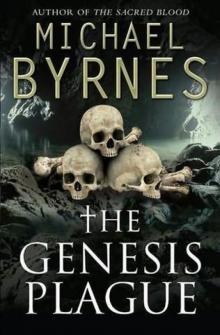 The Genesis Plague (2010)
The Genesis Plague (2010) The Genesis Plague
The Genesis Plague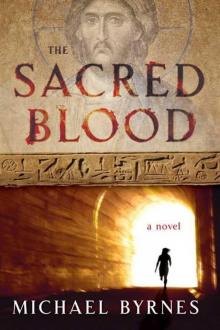 The Sacred Blood
The Sacred Blood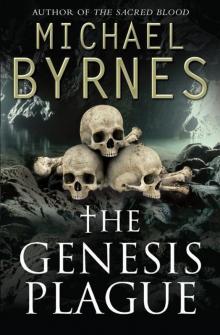 The Genesis Plague tf-1
The Genesis Plague tf-1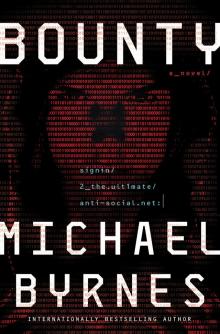 Bounty
Bounty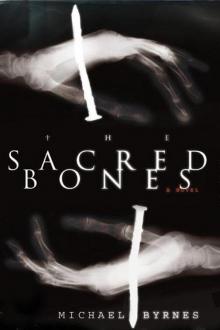 Sacred Bones : A Novel
Sacred Bones : A Novel